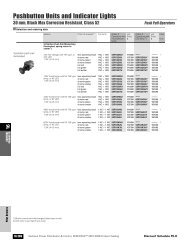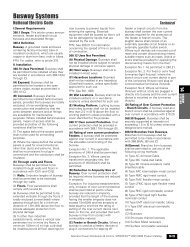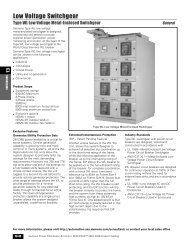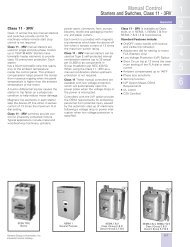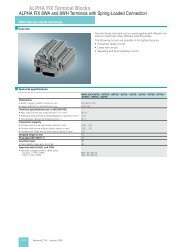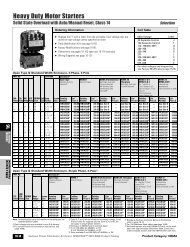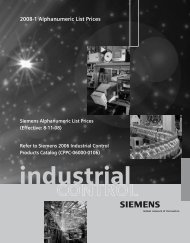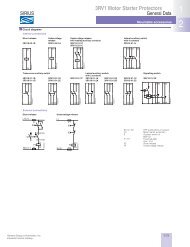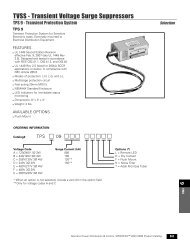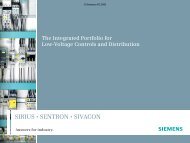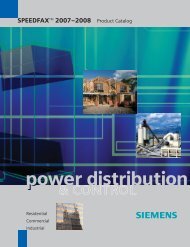Instrumentation & Controls - Siemens
Instrumentation & Controls - Siemens
Instrumentation & Controls - Siemens
Create successful ePaper yourself
Turn your PDF publications into a flip-book with our unique Google optimized e-Paper software.
<strong>Instrumentation</strong> & <strong>Controls</strong><br />
<strong>Instrumentation</strong><br />
& <strong>Controls</strong><br />
<strong>Siemens</strong> Power Generation<br />
Control System Training Programs 2006<br />
Power Generation
Training Catalog
Table of Contents<br />
General Training Information 2<br />
Course Overview and Curriculum 4<br />
Registration 6<br />
Course Descriptions<br />
Hardware/Software Configuration<br />
and Maintenance 8<br />
PCS7 Hardware Configuration/Maintenance 9<br />
TXP Hardware Configuration/Maintenance 10<br />
TXP Control Logic Configuration 11<br />
TXP Graphics Configuration 15<br />
TXP Control Logic Maintenance 16<br />
TXP Graphics Maintenance 17<br />
TXP Advanced Logic Configuration 18<br />
TXP Archiving, Reporting, and Calculation 19<br />
TXP System Administration 20<br />
PCS7 Control Logic Configuration 21<br />
PCS7 Graphics Configuration 22<br />
TXP Governor Familiarity 23<br />
TXP Operator Training 24<br />
TXP Turbine and Boiler Protection 25<br />
TXP Static Frequency Converter /<br />
Static Excitation System 26<br />
PCS7 Operator Training 27<br />
PCS7 Maintenance Training 28<br />
SPPA-T3000 Process Control System<br />
System Overview 29<br />
SPPA-T3000 Process Control System<br />
System Basics 30<br />
SPPA-T3000 Process Control System<br />
Advanced Engineering 31<br />
SPPA-T3000 Process Control System<br />
Operation and Monitoring 32<br />
SPPA-T3000 Process Control System<br />
System Maintenance 33
Your I&C Training Partner<br />
As the only OEM in the controls business, <strong>Siemens</strong><br />
Power Generation offers unparalleled power industry<br />
experience and customer service, backed by our global<br />
network of more than 30,000 power generation employees.<br />
We are committed to meeting and exceeding customer expectations<br />
and requirements to maximize our customers’ operating<br />
plant service.<br />
This commitment includes product knowledge transfer for<br />
our <strong>Instrumentation</strong> & <strong>Controls</strong> (I&C) customers. Our comprehensive,<br />
hands-on I&C customer training program gives<br />
your personnel the knowledge to troubleshoot and maintain<br />
your plant's control system. This ability can translate into<br />
shorter outage times, increased In-Market Availability (IMA),<br />
and increased profitability for your plant.<br />
Our training program is a critical component of the <strong>Siemens</strong><br />
solutions suite. We've designed our training solutions around<br />
the needs of the learner, incorporating solid curricula and<br />
blended learning techniques that include instructor-led and<br />
hands-on training. Our top-notch trainers have years of power<br />
plant and classroom training experience to meet the demands<br />
of today's plant professionals. Students leave understanding<br />
how the TXP control system integrates with existing equipment<br />
and with the confidence to operate and maintain the<br />
control systems throughout your fleet.<br />
Thank you for giving us the opportunity to serve your<br />
training needs. We appreciate your business and strive to<br />
do all we can to ensure that your company receives personal<br />
and professional I&C training.<br />
We always enjoy hearing from our customers, so please feel<br />
free to email us if you have feedback regarding our training<br />
solutions at I&C.Training@swpc.siemens.com<br />
1
Training Catalog<br />
General information<br />
It is our opinion that customer training is<br />
considered one of the most important parts of<br />
any project and is heavily emphasized within<br />
<strong>Siemens</strong> Power Generation. In line with our Total<br />
Quality Management and training policies,<br />
<strong>Siemens</strong> is able to provide a complete customer<br />
training program, which ensures full knowledge<br />
transfer.<br />
Exact training requirements, however, can vary<br />
considerably from customer to customer. For this<br />
reason, <strong>Siemens</strong> offers both standard training<br />
courses and customer specific training programs.<br />
To help you decide which course is more suitable<br />
for you, we have assigned experienced technical<br />
support professionals to help you with your training<br />
requirements.<br />
All classes are offered in Alpharetta, GA, unless<br />
otherwise noted.<br />
2 www.sea.siemens.com/sitrain
Training Catalog<br />
Typical courses cover:<br />
• System concept overview<br />
• System operation<br />
• Operating and monitoring system<br />
• Automation system<br />
• Engineering system<br />
• Network<br />
• Function modules<br />
• System planning, assembly, configuration,<br />
operation and servicing<br />
• Alarm and fault diagnosis<br />
• Field devices<br />
• System simulation/demonstration<br />
• Diagnostics and maintenance<br />
Training program<br />
<strong>Siemens</strong> will provide training<br />
support, additional courses,<br />
course extensions, or repeat<br />
courses for the customer<br />
throughout the lifetime<br />
of the installed system.<br />
In the event of such training,<br />
<strong>Siemens</strong> will discuss the precise<br />
requirements with the<br />
customer in order to agree<br />
to the necessary terms and<br />
conditions.<br />
• Possibilities to connect third-party components<br />
The courses also include the following:<br />
• Preparation material<br />
• <strong>Siemens</strong> overview<br />
• Visit to our manufacturing locations<br />
• Visit to our test center<br />
www.sea.siemens.com/sitrain 3
Course Overview<br />
On-site training<br />
When five or more people require training, on-site<br />
training can be the best value. The on-site course<br />
will include all course material, rental, and freight<br />
of equipment, as well as travel expenses of the instructor.<br />
The price for our standard on-site course is given upon<br />
request.<br />
In addition to the standard course, <strong>Siemens</strong> offers<br />
customized training specific to your power plant<br />
requirements. These courses will consist of training on<br />
plant specific hardware and software.<br />
These prices do not include student travel expenses<br />
and lodging. They are based on a minimum of five and<br />
a maximum of ten students in class.<br />
Our training facility<br />
All training takes place at our <strong>Instrumentation</strong> and<br />
<strong>Controls</strong> headquarters in Alpharetta, Georgia, located<br />
40 miles north of Atlanta’s Hartsfield International<br />
Airport. Our facility provides the control technology<br />
for all new power generation equipment along with<br />
retrofit and IT services for operating plants.<br />
Classrooms are equipped with actual TXP systems.<br />
Directions from Hartsfield International Airport<br />
• Take I-85 North<br />
• I-85 merges with I-75 in Atlanta but continue to follow<br />
the signs for I-85 North<br />
-Take Exit 87 (GA 400 N)<br />
• You will have to pay a $0.50 toll<br />
• Take Exit 12-B (McFarland Road)<br />
• You will have to pay a $ 0.50 toll<br />
• Take exit 12 (McFarland Road)<br />
• After merging onto McFarland, turn left into the second<br />
office park, Ridgeland<br />
• The <strong>Siemens</strong> building sits in the back on the right<br />
• Enter the building through the doors under the <strong>Siemens</strong><br />
sign<br />
4<br />
www.sea.siemens.com/sitrain
TXP Engineer Curriculums<br />
All courses are designed to stand alone. There are<br />
certain courses, however, that are optimized when<br />
completed as part of a curriculum.<br />
Purchase of a complete curriculum will entitle the<br />
customer to a discounted price. Students will also<br />
receive a Curriculum Completion Certificate with<br />
the successful completion of all course work.<br />
Look for the color-coded boxes to determine<br />
which courses fall under which curriculum.<br />
TXP Software Engineer<br />
Responsible for tasks involving all aspects of<br />
TXP Software Engineering using the Engineering<br />
Workstation. These tasks include Conceptual<br />
Design; Equipment Arrangement; Connections to<br />
Foreign Systems; Hardware, Software and Graphics<br />
Implementation; Testing; Commissioning and<br />
Maintenance.<br />
TXP <strong>Controls</strong> Engineer<br />
Responsible for tasks involving all aspects of TXP<br />
Logic. These tasks include Hardware and Software<br />
Implementation; Testing; Commissioning and<br />
Maintenance.<br />
TXP Graphics Engineer<br />
Responsible for tasks involving all aspects of<br />
TXP Operator Graphics using the Engineering<br />
Workstation. These tasks include Graphic<br />
Implementation; Testing; Commissioning and<br />
Maintenance.<br />
TXP Advanced Engineer<br />
Responsible for tasks involving all aspects<br />
of the TXP System. This is the most complete<br />
TXP Curriculum.<br />
TXP System Engineer<br />
Responsible for tasks involving initial setup and<br />
maintenance of TXP equipment. These tasks include<br />
System Administration for the Automation System,<br />
the Operating and Monitoring System, Engineering<br />
Workstations, Diagnostic System, and the SIMATIC<br />
Industrial Ethernet.<br />
www.sea.siemens.com/sitrain<br />
5
Registration & Accommodations<br />
Four convenient<br />
ways to register<br />
Phone: (877) 442-8724<br />
Fax: (678) 256-1527<br />
Email: I&C.training@swpc.siemens.com<br />
Online: http://www.sea.siemens.com/sitrain<br />
Please provide<br />
the following<br />
information when<br />
you register<br />
• Course title, dates, and location<br />
• Your company name<br />
• Mailing address<br />
• Billing address<br />
• Telephone and fax number<br />
• Contact person<br />
• PO number<br />
A registration acknowledgement letter will be faxed to the<br />
student immediately after enrollment. A confirmation letter<br />
will be sent once payment has been received.<br />
Required<br />
prepayment<br />
The following payment methods are accepted:<br />
• Purchase order<br />
• Company check<br />
• Visa or MasterCard<br />
Payment must be received at least one week prior to the<br />
first day of class. Payments should be mailed to:<br />
<strong>Siemens</strong> Power Generation<br />
<strong>Instrumentation</strong> & <strong>Controls</strong><br />
Attn: Customer Training<br />
1345 Ridgeland Parkway, Suite 116<br />
Alpharetta, GA 30004<br />
Please include student name, course title, and course date<br />
with your payment.<br />
Cancellation<br />
and refunds<br />
Cancellation requests must be made at least one week prior to<br />
class start date for a full refund. Only 50% of tuition will be<br />
refunded for cancellations made less than one week prior to<br />
start of class. Students who do not attend a class without prior<br />
notification will be charged in full.<br />
6<br />
www.sea.siemens.com/sitrain
TXP Process Control System<br />
8<br />
TXP Process Control System<br />
On-Site Hardware/<br />
Software Configuration<br />
and Maintenance<br />
TXP-HW/SW<br />
3 weeks - price upon request<br />
Maximum of 10 students<br />
This course is usually scheduled on site.<br />
Prerequisites<br />
Electrical engineer, electronics<br />
technician, or competent individual<br />
with electronics background.<br />
Description<br />
This course will teach the<br />
participants the functions of an<br />
operating and monitoring system<br />
and how to operate it as a human<br />
machine interface (HMI). It will<br />
cover all tasks associated with<br />
process management and information.<br />
It will begin by covering<br />
the theory and operation of TXP<br />
hardware components and how<br />
they interact. Students will learn<br />
a practical approach to diagnosing<br />
and isolating faults to the card<br />
level using the various TXP<br />
tools, and will be required to<br />
troubleshoot actual hardware and<br />
software problems. Instruction on<br />
standard TXP hardware platforms<br />
will include hands-on labs covering<br />
their configuring and testing.<br />
This course will also emphasize<br />
the tasks performed by most<br />
instrument or computer technicians<br />
to isolate software problems<br />
and make system changes. This<br />
course will describe the general<br />
use and functions of the various<br />
components in the TXP system.<br />
Emphasis will be placed on the<br />
Engineering Station for the<br />
modification of logic diagrams,<br />
graphics for analog, and digital<br />
control. This course is based on<br />
TXP version 7 level software and<br />
hardware.<br />
Objectives<br />
Upon successful completion of this course, the student<br />
has been trained to:<br />
• Explain the operation of the TXP plant bus and<br />
terminal bus<br />
• Isolate card failures and configure a replacement<br />
card<br />
• Make all necessary settings to standard<br />
communications cards<br />
• Perform required preventive maintenance<br />
• Distinguish between hardware and software<br />
problems<br />
• Troubleshoot a TXP system using a logical approach<br />
• Create logic diagrams for an actual process model<br />
• Create graphics for same process model<br />
• Modify logic diagrams<br />
• Modify graphics<br />
• Compile and download configured software<br />
Course contents<br />
A. TXP overview<br />
1. TXP plant bus operation<br />
a. Theory of operation<br />
b. Protocol<br />
c. Communication processors<br />
2. TXP terminal bus operation<br />
a. TCP/IP basics<br />
b. Data exchange between nodes<br />
3. Automation system components<br />
a. System architecture and loading procedures<br />
b. Process I/O<br />
c. Digital I/O cards<br />
d. Analog I/O cards<br />
4. Operating and monitoring system components<br />
B. Troubleshooting<br />
1. Hardware problem solving<br />
2. Software problem solving<br />
C. Program development and modification<br />
1. Function plan editor<br />
2. Graphics editor<br />
3. Logic code compiling and downloading<br />
4. Graphics compiling and downloading<br />
D. Operator interaction<br />
1. Alarm acknowledgement<br />
2. Online configurable trends<br />
3. Window management<br />
4. Online dynamic tuning and troubleshooting<br />
5. Archiving and data logging
TXP Process Control System<br />
Prerequisites<br />
Electrical engineer, electronics technician, or competent<br />
individual with an electronics background. Prior experience<br />
with DCS control systems is desirable.<br />
Description<br />
This course will cover the theory and operation of PCS7<br />
hardware components and how they interact. Students<br />
will learn a practical approach to diagnosing and isolating<br />
faults to the card level using the various PCS7 tools,<br />
and will be required to troubleshoot actual hardware<br />
and software problems. Instruction on standard PCS7<br />
hardware platforms will include hands-on labs covering<br />
configuring, cleaning, and testing.<br />
Objectives<br />
Upon successful completion of this course, the student<br />
has been trained to:<br />
• Explain the operation of the PCS7 bus system<br />
• Isolate card failures and configure a replacement card<br />
• Make all necessary settings to standard communications<br />
cards<br />
• Perform required preventive maintenance<br />
• Distinguish between hardware and software problems<br />
• Troubleshoot a PCS7 system using a logical approach<br />
Course contents<br />
A. System architecture and loading procedures<br />
1. PCS7 bus system<br />
a. Theory of operation<br />
b. Protocol<br />
c. Communication processors<br />
2. Process I/O<br />
a. Digital I/O cards<br />
b. Analog I/O cards<br />
3. Hardware assembly<br />
a. Assembly of automation rack<br />
b. Initialization and code transfer<br />
B. Troubleshooting<br />
1. Module level<br />
2. Rack level<br />
Process Control System<br />
PCS7 Hardware Configuration/<br />
Maintenance<br />
PCS7 – HW<br />
(4.5 days) - $2,600.00<br />
June 5-9, 2006<br />
October 23-27, 2006<br />
Top five reasons to take a<br />
PCS7 training course<br />
1. Less down-time due to fast<br />
operator response and action<br />
2. Proper system maintenance<br />
ensures stable operation<br />
3. The courses provide system<br />
knowledge to help assist<br />
students in troubleshooting<br />
4. A well-trained operator<br />
will perform all functions<br />
efficiently<br />
5. Knowledge of the system<br />
ensures higher self-esteem<br />
and confidence in doing the<br />
job right<br />
www.sea.siemens.com/sitrain<br />
9
TXP Process Control System<br />
TXP Process Control System<br />
Hardware Configuration/<br />
Maintenance<br />
TXP-HW<br />
1 week - $2,650.00<br />
February 13-17, 2006<br />
July 10-14, 2006<br />
December 4-8, 2006<br />
Prerequisites<br />
Electrical engineer, electronics technician, or competent<br />
individual with an electronics background. Prior experience<br />
with DCS control systems is desirable.<br />
Description<br />
This course will cover the theory and operation of TXP<br />
hardware components and how they interact. Students<br />
will learn a practical approach to diagnosing and isolating<br />
faults to the card level using the various TXP tools, and<br />
will be required to troubleshoot actual hardware and<br />
software problems. Instruction on standard TXP hardware<br />
platforms will include hands-on labs covering their<br />
configuring, cleaning, and testing. This course is based<br />
on TXP version 7 level software and hardware.<br />
Objectives<br />
Upon successful completion of this course, the student<br />
has been trained to:<br />
• Explain the operation of the TXP plant bus and<br />
terminal bus<br />
• Isolate card failures and configure a replacement card<br />
• Make all necessary settings to standard communications<br />
cards<br />
• Perform required preventive maintenance<br />
• Distinguish between hardware and software<br />
problems<br />
• Troubleshoot a TXP system using a logical approach<br />
Course contents<br />
A. System architecture and loading procedures<br />
1. TXP plant bus and terminal Bus<br />
a. Theory of operation<br />
b. Protocol<br />
c. Communication processors<br />
d. TCP/IP basics<br />
2. Process I/O<br />
a. Digital I/O cards<br />
b. Analog I/O cards<br />
3. Hardware assembly<br />
a. Assembly of automation rack<br />
b. Initialization and code transfer<br />
B. Troubleshooting<br />
1. Module level<br />
2. Rack level<br />
10<br />
www.sea.siemens.com/sitrain
Registration & Accommodations<br />
<strong>Siemens</strong> reserves the right to change the schedule<br />
or discontinue or cancel courses if an insufficient<br />
number of students have enrolled. In the event<br />
that students are enrolled in courses that have<br />
been changed or canceled, <strong>Siemens</strong> will notify<br />
these students two weeks prior to the scheduled<br />
starting date. These students will be given first<br />
priority to enroll in the next scheduled class.<br />
Right to<br />
cancellation<br />
Hilton Garden Inn<br />
4025 Windward Plaza<br />
(770) 360-7766<br />
Local<br />
accommodations<br />
Marriott Alpharetta<br />
5750 Windward Parkway<br />
(770) 754-9600<br />
Marriott Courtyard<br />
12655 Deerfield Parkway<br />
(678) 366-3360<br />
AmeriSuites<br />
12505 Cingular Way<br />
(678) 339-0505<br />
AmeriSuites<br />
5595 Windward Parkway<br />
(770) 343-9566<br />
www.sea.siemens.com/sitrain<br />
7
TXP Process Control System<br />
Prerequisites<br />
A basic background in logic control and digital<br />
computer techniques. Prior completion of<br />
Hardware Configuration/Maintenance (TXP-HW)<br />
is recommended.<br />
Description<br />
This course emphasizes the tasks performed by<br />
most operators and instrumentation technicians.<br />
This course will describe the general use and<br />
functions of the various components in the<br />
TXP system. Emphasis will be placed on the<br />
engineering workstation for the creation of logic<br />
diagrams. The student will create a complete<br />
control system model using the function plan<br />
editor in the ES680 workstation.<br />
TXP Process Control System<br />
Control Logic Configuration<br />
TXP - CLC<br />
1 week - $2,650.00<br />
February 20-24, 2006<br />
July 17-21, 2006<br />
December 11-15, 2006<br />
Objectives<br />
Upon successful completion of this course, the<br />
student has been trained to:<br />
• Create logic diagrams for actual process model<br />
• Modify logic diagrams<br />
• Compile and download configured software to<br />
applicable TXP control system<br />
• Apply simulations<br />
Course contents<br />
A. TXP overview<br />
1. Communication bus operation<br />
2. Engineering workstation<br />
3. Automation system operation<br />
4. Operating and monitoring operation<br />
B. Program development and modification<br />
1. Functional logic<br />
2. Logic code compiling and downloading<br />
C. Engineering workstation user interface<br />
1. Window management<br />
2. Online dynamic simulation and<br />
troubleshooting<br />
www.sea.siemens.com/sitrain<br />
11
TXP Software Engineer<br />
TXP <strong>Controls</strong> Engineer<br />
TXP Graphics Engineer<br />
TXP Advanced Engineer<br />
TXP System Engineer<br />
Code Course Name JAN<br />
TXP-HW/SW<br />
TXP Hardware/Software<br />
Configuration & Maintenance<br />
PCS7-HW<br />
Hardware Configuration<br />
& Maintenance<br />
12<br />
TXP-HW TXP Hardware 1<br />
TXP-CLC TXP Control Logic 2<br />
Configuration<br />
TXP-GC<br />
TXP Graphics Configuration<br />
TXP-CLM<br />
TXP Control Logic Maintenance<br />
TXP-GM<br />
TXP Graphics Maintenance<br />
TXP-ALC<br />
TXP Advanced Logic<br />
Configuration<br />
TXP-ARC<br />
TXP Archiving, Reporting,<br />
and Calculation<br />
TXP-ADM<br />
TXP System Administration<br />
PCS7-CLC<br />
Control Logic Configuration<br />
PCS7-GC<br />
Graphics Configuration<br />
TXP-GOV<br />
TXP Governor Familiarity<br />
TXP-OP<br />
TXP Operator Training<br />
TXP-95F<br />
TXP Turbine and Boiler Protection<br />
SFC/SES<br />
Static Frequency Converter<br />
Static Excitation System<br />
PCS7-OP<br />
Operator Training<br />
PCS7-MAINT Maintenance Trainig<br />
T3K-OV<br />
SPPA-T3000 Process Control System<br />
T3K-BAS<br />
T3000 Process Control System<br />
T3K-ADV<br />
SPPA-T3000 Process Control System<br />
T3K-OP<br />
SPPA-T3000 Process Control System<br />
T3K-MNT<br />
SPPA-T3000 Process Control System
FEB MAR APR MAY JUN JUL AUG SEP OCT NOV DEC<br />
6-10 24-28<br />
3-17 10-14 4-8<br />
0-24 17-21 11-15<br />
27-3 24-28 18-22<br />
20-24<br />
22-26 11-15<br />
8-12<br />
10-21 25-6<br />
12-16 30-4<br />
19-23 6-10<br />
22-26 23-27<br />
26 9<br />
13 31 4<br />
20 7 11<br />
13
Let us come to you…<br />
Do you have a group of five or more employees<br />
taking the same course Take advantage of our<br />
on-site training. Benefits of on-site training include:<br />
• Convenience<br />
• Customized training<br />
• Save time and money<br />
• Team learning<br />
Email us: I&C.Training@swpc.siemens.com<br />
14 www.sea.siemens.com/sitrain
TXP Process Control System<br />
Prerequisites<br />
A basic background in modulating and logic<br />
control and in digital computer techniques.<br />
Prior completion of Control Logic Configuration<br />
(TXP-CLC) is recommended.<br />
Description<br />
This course emphasizes the tasks performed<br />
by most instrument or computer technicians to<br />
configure and modify a human machine interface<br />
(HMI) for operation of power plant equipment.<br />
This course describes the general use and functions<br />
of the various components in the TXP system.<br />
Emphasis will be placed on the engineering<br />
workstation for the creation of graphics. The<br />
student will create a complete graphics package<br />
model using the HMI graphics editor in the<br />
engineering workstation.<br />
TXP Process Control System<br />
Graphics Configuration<br />
TXP-GC<br />
1 week - $2,650.00<br />
February 27 - March 3, 2006<br />
July 24-28, 2006<br />
December 18-22, 2006<br />
Objectives<br />
Upon successful completion of this course,<br />
the student has been trained to:<br />
• Create and modify graphics<br />
• Compile and download configured graphics<br />
• Link graphics to logic function plans<br />
Course contents<br />
A. TXP overview<br />
B. Program development and modification<br />
1. Graphics editor (HMI)<br />
2. Configure plant displays, trends<br />
3. Set up graphical hierarchy<br />
4. Graphics compiling and downloading<br />
C. Operator interaction<br />
1. Alarm acknowledgement<br />
2. Online configurable trends<br />
3. Window management<br />
www.sea.siemens.com/sitrain<br />
15
TXP Process Control System<br />
TXP Process Control System<br />
Control Logic Maintenance<br />
TXP-CLM<br />
1 week - $2,650.00<br />
March 20-24, 2006<br />
Prerequisites<br />
A basic background in logic control and digital<br />
computer techniques. Prior completion of Control<br />
Logic Configuration (TXP-CLC) is recommended.<br />
Description<br />
This course for maintenance personnel describes<br />
the various components in the TXP system and<br />
maintaining plant equipment using the engineering<br />
workstation. Students will make changes to the<br />
input/output configuration adding new I/O points, and<br />
troubleshoot the logic and code. Students will learn to<br />
perform dynamic function changes as well as add and<br />
remove simulations.<br />
Objectives<br />
Upon successful completion of this course, the student<br />
has been trained to:<br />
• Troubleshoot TXP logic using the engineering<br />
workstation<br />
• Initialize standard settings on communication and<br />
I/O cards<br />
• Distinguish between hardware and software<br />
problems<br />
• Explain the difference between dynamic parameter<br />
changes and online and offline code transfers<br />
Course contents<br />
A. TXP overview<br />
B. Logic development and maintenance<br />
1. Adding hardware modules and I/O points<br />
2. Dynamic parameter changes, dynamic<br />
function plans<br />
3. Applying simulations<br />
4. Initialization of automation processor by<br />
programming an I/O flash card<br />
5. Communication processor card<br />
6. Code generation and transfer to applicable<br />
TXP computers<br />
C. Program and initialize an optical switch module<br />
D. Troubleshooting<br />
1. Hardware problem solving<br />
2. Software problem solving<br />
E. Use of SCO UNIX commands to verify status of CPU<br />
16<br />
www.sea.siemens.com/sitrain
TXP Process Control System<br />
Prerequisites<br />
A basic background in control system graphics<br />
and control logic, and prior experience with DCS<br />
control systems is desirable. Prior completion of<br />
Graphics Configuration (TXP-GC) is highly<br />
recommended.<br />
Description<br />
This course is designed for the technician<br />
responsible for graphics maintenance of the TXP<br />
system. Students will learn how to maintain TXP<br />
graphics with the human machine interface editor.<br />
They will also learn how to transfer new graphic<br />
displays into an existing project and work with<br />
configurable trends.<br />
TXP Process Control System<br />
Graphics Maintenance<br />
TXP-GM<br />
1 week - $2,650.00<br />
May 22-26, 2006<br />
September 11-15, 2006<br />
Objectives<br />
Upon successful completion of this course,<br />
the student has been trained to:<br />
• Make changes to graphics as required<br />
• Explain the process connection between function<br />
plan logic and human machine interface graphics<br />
• Navigate through operating and monitoring<br />
symbol library<br />
• Explain the code generation and transfer process<br />
Course contents<br />
A. TXP overview<br />
B. Graphic development and modification<br />
1. Create the graphics for an existing system<br />
2. Make process connections between the<br />
function plan editor and operating and<br />
human machine interface editor<br />
3. Create dynamic function plans<br />
4. Generate and transfer new or modified<br />
graphics<br />
C. Troubleshooting<br />
1. Code generation and transfer<br />
2. Process connections<br />
3. Software problem solving<br />
4. Recovery of deleted symbols from the<br />
graphics standard library<br />
www.sea.siemens.com/sitrain 17
TXP Process Control System<br />
TXP Process Control System<br />
Advanced Logic Configuration<br />
TXP-ALC<br />
1 week - $2,650.00<br />
May 8-12, 2006<br />
Prerequisites<br />
A basic background in logic control, TXP logic and<br />
digital computer techniques. Prior completion<br />
of Control Logic Configuration (TXP-CLC) is<br />
recommended.<br />
Description<br />
This course emphasizes the tasks performed by<br />
design and maintenance personnel. This course<br />
describes various advanced logical functions in the<br />
TXP system. Participants will work with the engineering<br />
workstation to design open- and closed-loop logic<br />
functions. The standard TXP manual will be used as a<br />
reference.<br />
Objectives<br />
Upon successful completion of this course, the student<br />
has been trained to:<br />
• Create and configure open-loop control functions<br />
• Create and configure closed-loop control functions<br />
• Troubleshoot TXP logic<br />
Course contents<br />
A. TXP overview<br />
B. Program development and modification<br />
1. Open-loop control logic functions<br />
2. Closed-loop control logic functions<br />
C. Code generation and transfer to applicable<br />
TXP computers<br />
D. Control logic troubleshooting<br />
18 www.sea.siemens.com/sitrain
TXP Process Control System<br />
Prerequisites<br />
A basic background in control systems and prior<br />
DCS knowledge is desirable. Prior completion of<br />
Control Logic Configuration (TXP-CLC) is highly<br />
recommended.<br />
Description<br />
This course emphasizes tasks performed by lead<br />
technicians and operators. This course will<br />
describe the various components of the TXP<br />
system. During the span of this course, the student<br />
will work with the engineering workstation,<br />
operating terminal, processing unit, and server<br />
unit to better understand archiving, reporting,<br />
and calculation, and the magnetic optical disk.<br />
The student will also learn about logs, alarm<br />
handling, switch cycle counters, and operating<br />
hours.<br />
TXP Process Control System<br />
Archiving, Reporting,<br />
and Calculation<br />
TXP-ARC<br />
1 week - $2,650.00<br />
This special course is<br />
scheduled as needed.<br />
Objectives<br />
Upon successful completion of this course,<br />
the student has been trained to:<br />
• Design and implement cycle counters, operating<br />
hour counters and other process information<br />
related calculations<br />
• Design and implement reports such as shift<br />
reports and event reports<br />
• Check and maintain the TXP alarm handling<br />
function blocks<br />
• Maintain and monitor the long-term archive<br />
and its storage media<br />
Course contents<br />
A. TXP overview<br />
B. Program development and modification<br />
1. Create logic for logs, alarm handler<br />
and counters<br />
2. Generate and transfer software code<br />
3. Load code into redundant processing<br />
unit, server unit, and operating terminal<br />
4. Monitor performance of TXP system<br />
C. Troubleshooting<br />
1. Magnetic optical disk resetting and<br />
restoring<br />
2. Alarm handling<br />
3. Analog and binary signals for<br />
processing unit logic counters<br />
www.sea.siemens.com/sitrain<br />
19
TXP Process Control System<br />
20<br />
TXP Process Control System<br />
System Administration<br />
TXP-ADM<br />
2 weeks - $5,300.00<br />
April 10-21, 2006<br />
September 25 - October 6, 2006<br />
Objectives<br />
Upon successful completion of this<br />
course, the student has been trained<br />
to:<br />
• Understand the basics of the UNIX<br />
operating system<br />
• Use the VI editor for file editing<br />
• Identify engineering station and<br />
operating and monitoring system<br />
hardware components<br />
• Understand the structure of engineering<br />
station and operating and<br />
monitoring system software<br />
• Query the project database using<br />
standard query language (SQL)<br />
• Identify operating and monitoring<br />
components and which object<br />
managers are running on each<br />
• Understand the structure of the<br />
operating and monitoring file<br />
system<br />
• Interpret the meaning of the internal<br />
identification numbers (IKZ’s)<br />
• Configure all necessary files for<br />
proper operating and monitoring<br />
operation<br />
• Understand the data transfer<br />
between the engineering station<br />
and operating and monitoring<br />
systems<br />
• Understand the automation system<br />
to operating and monitoring<br />
coupling<br />
• Install printers and troubleshoot<br />
printing problems<br />
• Use the various operating and<br />
monitoring tools<br />
• Schedule system back-ups<br />
Prerequisites<br />
A basic background in digital computer techniques and prior<br />
experience with DCS control systems is desirable. Prior completion<br />
of Hardware Configuration/Maintenance (TXP-HW) is highly<br />
recommended.<br />
Description<br />
This course is designed for the technician responsible for the<br />
computer network administration of a TXP system. This course<br />
emphasizes the tasks performed by most computer technicians<br />
to isolate system problems and basic network administration.<br />
This course will cover the basics of the UNIX operating system:<br />
the VI editor, the database system INGRES, printing, and all<br />
associated administrative tasks on the engineering system.<br />
Program components of the operating and monitoring system<br />
software, the file system structure, data transfer between the<br />
operating and monitoring system and engineering station,<br />
automation system to operating and monitoring coupling, and<br />
all administrative tasks on the operating and monitoring system<br />
will also be covered.<br />
Course contents<br />
A. Introduction to UNIX<br />
1. Operating system basics<br />
2. Most commonly used<br />
commands<br />
3. Use of variables<br />
B . Santa Cruz Operation (SCO) UNIX<br />
1. Style manager 3. Window manager<br />
2. File manager 4. Session manager<br />
C. Editors<br />
1. VI editor 2. SCO desktop editor<br />
D. Engineering station hardware<br />
E. Engineering station software<br />
F. Overview of project database and standard query language<br />
G. Program components of the operating and monitoring<br />
system software<br />
1. Object managers<br />
2. Operating and monitoring PC structures<br />
H. File system structure of operating and monitoring<br />
system PCs<br />
I. Meaning of the internal identification numbers (IKZ’s)<br />
J. Configuration data in the operating and monitoring system<br />
K. Data transfer between the engineering station and operating<br />
and monitoring system<br />
L. Automation system to operating and monitoring system<br />
coupling<br />
M. Operating and monitoring tools<br />
N. Diagnostics<br />
O. Back-ups<br />
P. Printing
TXP Process Control System<br />
Prerequisites<br />
A basic background in logic control and digital<br />
computer techniques. Prior completion of Hardware<br />
Configuration Maintenance (PCS7-HW) is recommended.<br />
Description<br />
This course emphasizes the tasks performed by<br />
most operators and instrumentation technicians.<br />
This course will describe the general use and<br />
functions of the various components in the PCS7<br />
system. Emphasis will be placed on the engineering<br />
workstation for the creation of logic diagrams. The<br />
student will create a complete control system model<br />
using the engineering workstation.<br />
Process Control System<br />
PCS7 Control Logic Configuration<br />
PCS7 – CLC<br />
(4.5 days) $2,600.00<br />
June 12-16, 2006<br />
October 30 – November 3, 2006<br />
Objectives<br />
Upon successful completion of this course, the<br />
student has been trained to:<br />
• Create logic diagrams for actual process model<br />
• Modify logic diagrams<br />
• Compile and download configured software to<br />
applicable PCS7 control system<br />
• Apply simulations<br />
Course contents<br />
A. PCS7 overview<br />
1. Communication bus operation<br />
2. Engineering workstation<br />
3. Automation system operation<br />
4. Operator station operation<br />
B. Program development and modification<br />
1. Functional logic<br />
2. Logic code compiling and downloading<br />
C. Engineering workstation user interface<br />
1. Window management<br />
2. Online dynamic simulation and<br />
troubleshooting<br />
www.sea.siemens.com/sitrain 21
TXP Process Control System<br />
Process Control System<br />
PCS7 Graphics Configuration<br />
PCS7 – GC<br />
(4.5 days) $2,600.00<br />
June 19-23, 2006<br />
November 6-10, 2006<br />
Prerequisites<br />
A basic background in logic control and digital computer<br />
techniques. Prior completion of Control Logic Configuration<br />
(PCS7-CLC) is recommended.<br />
Description<br />
This course emphasizes the tasks performed by most instrument<br />
or computer technicians to configure and modify a<br />
human machine interface (HMI) for operation of power<br />
plant equipment.<br />
This course describes the general use and functions of the<br />
various components in the PCS7 system. Emphasis will be<br />
placed on the engineering workstation for the creation of<br />
graphics. The student will create a complete graphics package<br />
model using the WinCC graphics editor on the engineering<br />
workstation.<br />
Objectives<br />
Upon successful completion of this course, the student has<br />
been trained to:<br />
• Create and modify graphics<br />
• Compile and download configured graphics<br />
• Link graphics to logic function plans<br />
Course contents<br />
A. PCS7 overview<br />
B. Program development and modification<br />
1. Graphics editor (WinCC)<br />
2. Configure plant displays and trends<br />
3. Set up graphical hierarchy<br />
4. Graphics compiling and downloading<br />
C. Operator interaction<br />
1. Alarm acknowledgement<br />
2. Online configurable trends<br />
3. Window management<br />
22<br />
www.sea.siemens.com/sitrain
TXP Process Control System<br />
Prerequisites<br />
A basic background in modulating and logic<br />
control and in digital computer techniques and<br />
prior experience with DCS control systems is<br />
desirable. Prior completion of Hardware<br />
Configuration/Maintenance (TXP-HW) and<br />
Control Logic Configuration (TXP-CLC) is highly<br />
recommended.<br />
Description<br />
This course is designed for the technician<br />
responsible for the software maintenance of a TXP<br />
system. It describes the general use and functions<br />
of the various components in the TXP governor<br />
system SIMADYN®. Emphasis will be placed on<br />
the governor system hardware layout, drawing<br />
conventions used, the STRUC G programming<br />
language, and troubleshooting techniques.<br />
Course contents<br />
A. Closed-loop control concepts<br />
B. Governor functional description<br />
1. Speed, load, and outlet temperature<br />
control (OTC) controllers<br />
C. Governor system hardware overview<br />
1. General cabinet layout for both gas<br />
turbines that are marketed by <strong>Siemens</strong><br />
2. Signal converter overview/description<br />
D. Program development and modification<br />
1. Hardware drawing overview/description<br />
2. Governor system software drawing<br />
overview/description<br />
3. Block diagram functional sheets<br />
4. STRUC G software<br />
E. Troubleshooting<br />
1. Hardware and software faults<br />
2. IBS program on commissioning<br />
and diagnostic tool PG740<br />
F. Plant bus communications with automation<br />
system<br />
1. NML software on commissioning and<br />
diagnostic tool PG740<br />
TXP Process Control System<br />
Governor Familiarity Course<br />
TXP-GOV<br />
1 week - $2,650.00<br />
May 22-26, 2006<br />
October 23-27, 2006<br />
Objectives<br />
Upon successful completion of this<br />
course, the student has been<br />
trained to:<br />
• Understand basic closed-loop<br />
control concepts<br />
• Understand the basics of speed<br />
control, load control, and OTC<br />
control concepts<br />
• Identify individual hardware<br />
components in the governor<br />
cabinet<br />
• Read and understand hardware<br />
drawings<br />
• Read and understand software<br />
drawings<br />
• Troubleshoot common hardware<br />
and software problems using a<br />
commissioning and diagnostic<br />
tool PG740 and the IBS software<br />
program<br />
• Understand communication<br />
tasks between the governor<br />
system and automation system<br />
www.sea.siemens.com/sitrain<br />
23
TXP Process Control System<br />
TXP Process Control<br />
System Operator Training<br />
TXP-OP<br />
4 days - $3,000.00<br />
This special course is<br />
scheduled as needed.<br />
Objectives<br />
Upon successful completion<br />
of this course, the student<br />
has been trained to:<br />
• Identify TXP system<br />
components<br />
• Identify types of graphics<br />
• Navigate graphics<br />
• Recognize graphic symbols<br />
• Control analog and digital<br />
devices<br />
• Analyze faults<br />
• Configure trends<br />
• Create and record logs<br />
• Dynamically force values<br />
• Dynamically tune control<br />
loops<br />
Prerequisites<br />
Power plant operator or competent individual with<br />
a background in operating power plants.<br />
Description<br />
This course will teach the participants the functions<br />
of an OM650 system and how to operate it using the<br />
human machine interface (HMI). It will cover all tasks<br />
associated with process operation and information. It<br />
will begin with an overview of TXP. Students will learn<br />
a practical approach to monitor and operate control<br />
devices using TXP. Instruction on standard TXP<br />
hardware platforms will include hands-on labs covering<br />
operation of controlled devices. This course will<br />
describe the general use and functions of the various<br />
components in the TXP system. Emphasis will be<br />
placed on the operator terminal for analog and<br />
digital control. Course is based on TXP version 7<br />
level software and hardware.<br />
Course contents<br />
A. TXP operations<br />
1. Distributed control system<br />
a. Component identification<br />
2. Automation system<br />
3. Operating and monitoring (OM650)<br />
components and operation<br />
a. System architecture<br />
b. Display types<br />
c. Navigation and hierarchy<br />
d. Plant displays and symbols<br />
e. Operation windows<br />
f. Notebook feature<br />
g. Alarm analysis<br />
h. Online configurable trends<br />
i. Archiving and data logging<br />
4. Plant bus and terminal bus<br />
5. Engineering station<br />
a. Dynamic logic<br />
b. Simulating values<br />
6. Diagnostic system<br />
24<br />
www.sea.siemens.com/sitrain
TXP Process Control System<br />
Prerequisites<br />
A basic background in modulating and logic control<br />
and in digital computer techniques and prior experience<br />
with DCS control systems is desirable. Prior<br />
completion of Hardware Configuration/Maintenance<br />
(TXP-HW) and Control Logic Configuration (TXP-CLC)<br />
is highly recommended.<br />
Description<br />
This course will provide general knowledge in the<br />
areas of SIMATIC STEP 5 and MC5 programming<br />
languages as they are used in the generation of<br />
software for the turbine and boiler fail-safe<br />
protection system AS 620F.<br />
Course contents<br />
MODULE 1 (STEP 5 and MC5 programming):<br />
A. STEP 5 commands and MC5 machine code<br />
B. Methods of representation<br />
C. Operation types and operation areas<br />
D. Structured programming<br />
E. Block types and logic operations<br />
F. Creating and handling projects and<br />
program files<br />
G. Editing blocks<br />
H. Force variables<br />
I. EPROM handling & management<br />
J. Diagnostics<br />
MODULE 2 (protection system AS620F):<br />
A. General concepts of redundancy<br />
B. Design, functions and connections S5-95F<br />
C. Configuration and error diagnosis and<br />
elimination software package COM 95F<br />
D. Guidelines for configuration, passivation and<br />
depassivation, error localization, software and<br />
hardware alarms, SINEC L1, SINEC L2 with<br />
CP541<br />
E. Communication processor CP541<br />
TXP Process Control System<br />
Turbine & Boiler<br />
Protection System<br />
(SIMATIC S5 & 95F)<br />
TXP-95F<br />
4 days - $3,300.00<br />
This special course is<br />
scheduled as needed.<br />
Objectives<br />
Upon successful completion of<br />
this course, the student has<br />
been trained to:<br />
• Understand the principles of<br />
the SIMATIC STEP 5<br />
Language<br />
• Identify MC5 machine code<br />
• Identify AS 620F system<br />
components<br />
• Identify common system<br />
errors<br />
• Analyze faults<br />
www.sea.siemens.com/sitrain 25
TXP Process Control System<br />
TXP Process Control System<br />
Static Frequency Converter<br />
Static Excitation System<br />
SFC/SES<br />
5 days - $3,300.00<br />
This special course is<br />
scheduled as needed.<br />
Prerequisites<br />
Power plant operator or competent individual with<br />
a background in operating power plants. Prior<br />
completion of Hardware Configuration/Maintenance<br />
(TXP-HW) is highly recommended.<br />
Description<br />
This course will cover the theory and operation of<br />
the SFC/SES control unit used for the start up of gas<br />
turbines and excitation of the generator. Students<br />
will learn about the operation and maintenance<br />
procedures with hands on labs using a Simadyn<br />
D control unit.<br />
Objectives<br />
Upon successful completion of this course, the<br />
student has been trained to:<br />
• Understand the equipment arrangement<br />
• Interpret the electrical schematic diagrams<br />
for the generator excitation<br />
• Identify the limits imposed by software<br />
• Understand the system functionality<br />
• Investigate the sequences involved in start up<br />
• Read the system schematic and software diagrams<br />
• Analyze hardware and software faults<br />
• Carry out routine system maintenance<br />
Course contents<br />
A. Introduction to plant set-up<br />
B. Power section SES<br />
C. Generator diagrams<br />
D. SFC functionality<br />
E. Modes of SFC operation<br />
F. Hardware description<br />
G. Interpreting schematic and software diagrams<br />
H. Fault detection<br />
I. Routine maintenance<br />
J. Use of OP1 interface module<br />
26<br />
www.sea.siemens.com/sitrain
TXP Process Control System<br />
Prerequisites<br />
Power plant operator or competent individual with a<br />
background in operating power plants.<br />
Description<br />
This course will teach the participants the functions of<br />
WinCC and how to operate it using the human machine<br />
interface (HMI). It will cover all tasks associated with<br />
process operation and information. It will begin with<br />
an overview of PCS7. Students will learn a practical<br />
approach to monitor and operate control devices using<br />
a plant specific simulation of the PCS7 system. The<br />
simulation will be used for hands-on labs covering<br />
startup, shutdown, over speed and valve testing. This<br />
course will describe the general use and functions of<br />
the various components in the PCS7 system. Emphasis<br />
will be placed on the operator station for analog and<br />
digital control.<br />
Process Control System<br />
PCS7 Operator Training<br />
PCS7 – OP<br />
(1 day) $1,350.00<br />
PCS7<br />
Course contents<br />
A. PCS7 operations<br />
1. Distributed control system<br />
a. Component identification<br />
2. Automation system<br />
3. Operator station (OS) components and operation<br />
a. System architecture<br />
b. Display types<br />
c. Navigation and hierarchy<br />
d. Plant displays and symbols<br />
e. Operation windows<br />
f. Alarm analysis<br />
g. Online configurable trends<br />
4. Bus system<br />
5. Engineering station<br />
a. Dynamic logic<br />
b. Simulating values<br />
6. Diagnostics<br />
www.sea.siemens.com/sitrain 27
TXP Process Control System<br />
Process Control System<br />
PCS7 Maintenance Training<br />
PCS7 – MAINT<br />
(3 days) $2,000.00<br />
Course contents<br />
A. PCS7 overview<br />
B. Engineering workstation<br />
overview<br />
1. Hardware modules and<br />
I/O points<br />
2. Parameter changes,<br />
dynamic function plans<br />
3.Startup and shutdown of<br />
Engineering components<br />
4.Replacement of the<br />
automation processor<br />
5.Replacement of the<br />
communication processor<br />
card<br />
6.Redundancy concepts<br />
C. Program and initialize and<br />
loading<br />
D. Configuration of the MP55<br />
Signal conditioning module<br />
E. Configuration of the axiomatic<br />
voltage to current converters<br />
F. System troubleshooting<br />
1. Dynamic value status<br />
monitoring mode<br />
2. Function code navigation<br />
3. Trip string evaluation<br />
Prerequisites<br />
A basic background in logic control and digital<br />
computer techniques. Prior completion of Control<br />
Logic Configuration (PCS7-CLC) is recommended.<br />
Description<br />
This course for maintenance personnel describes the<br />
various components in the PCS7 system and maintaining<br />
the system using the engineering workstation or<br />
project delivered tools. Students will navigate through<br />
their project to understand the HW and Logic configuration,<br />
configure the valve position feedback instrumentation,<br />
and understand the various protection<br />
devices.<br />
Objectives<br />
Upon successful completion of this course, the student<br />
has been trained to:<br />
• Troubleshoot PCS7 system logic using the<br />
engineering workstation<br />
• Initialize standard settings on communication and<br />
I/O cards<br />
• Distinguish between hardware and software<br />
problems<br />
• Configure the valve feedback instrumentation<br />
• Understand the turbine trip string<br />
28<br />
www.sea.siemens.com/sitrain
TXP Process Control System<br />
Prerequisites<br />
None<br />
Description<br />
This course will cover the overall concepts of SPPA-<br />
T3000 Process Control System. Students will be<br />
exposed to all the different components of the SPPA-<br />
T3000 system and a general understanding of how they<br />
interact. Instruction on standard SPPA-T3000 hardware<br />
platforms will include hands-on demonstrations.<br />
SPPA-T3000 Process<br />
Control System<br />
System Overview<br />
T3K-OV<br />
(1 day)<br />
June 26 - October 9, 2006<br />
Alpharetta training center or on site<br />
Objectives<br />
Upon successful completion of this course, the student<br />
will be able to:<br />
• Identify individual components in the SPPA-T3000<br />
Process Control System<br />
• Explain the tasks of the application and automation<br />
servers<br />
• Explain the functions of operation, engineering and<br />
diagnostic views<br />
• Explain the communications between all components<br />
• Understand the concepts of turbine control and<br />
third party connections<br />
Course contents<br />
• Introduction to the SPPA-T3000 control system<br />
• Highlights and advantages<br />
• System architecture<br />
• Peripherals<br />
• System documentation<br />
• Engineering view: function diagram, plant display,<br />
archive<br />
• Operation: faceplates, trends, alarms, reports, user<br />
specific plant displays<br />
• Diagnostic: force, change of parameters<br />
• Commissioning: point view<br />
• Concept: turbine control, (failsafe), modbus<br />
(Connect/90)<br />
• Online system demonstration<br />
www.sea.siemens.com/sitrain 29
TXP Process Control System<br />
T3000 Process<br />
Control System<br />
System Basics<br />
T3K-BAS<br />
(4 days) $2,600.00<br />
March 13 - July 31 - December 4, 2006<br />
Alpharetta training center or on site<br />
Prerequisites<br />
Electrical Engineer, electronics technician or competent<br />
individual with an electronics background and<br />
knowledge of PC operations using MS Windows. Prior<br />
experience with a DCS control system is desirable.<br />
Description<br />
The participant will learn the basic principles and<br />
views of I&C engineering, diagnostics and operation of<br />
the SPPA-T3000 system. Each student will implement a<br />
basic control system model, using the workbench to<br />
create both function diagrams and plant displays.<br />
Emphasis will be placed on sensor processing/coupling<br />
for analog and binary signals, along with motor/actuator<br />
control applications.<br />
Objectives<br />
Upon successful completion of this course, the student<br />
will be able to:<br />
Course contents<br />
• System hardware and software<br />
architecture, redundancy<br />
• Peripherals<br />
• System documentation<br />
• Engineering: function diagram,<br />
plant display, archive<br />
• Integrated engineering,<br />
using AF-blocks and prototypes,<br />
creating macros, creating trend<br />
displays<br />
• Operation: faceplates, trends,<br />
alarms, displays navigation<br />
• Diagnostic: change of parameters,<br />
dynamic function diagram,<br />
forcing ports<br />
• Commissioning: point view<br />
• Basic graphics, display hierarchy<br />
• Engineering examples: I/Os,<br />
logic, motor, graphics<br />
• SPPA-T3000 system summary<br />
• Implementation of basic<br />
functions (practical exercises):<br />
- hardware engineering using<br />
HW proxies<br />
- processing binary and analog<br />
values<br />
- motor control, actuator,<br />
protection<br />
- graphic layout of plant displays<br />
• Explain the operation of the control system<br />
and network<br />
• Identify the systems HW components<br />
• Navigate through the online documentation<br />
• Distinguish between hardware and software<br />
problems<br />
• Create logic and process diagrams for an<br />
actual plant model<br />
• Understand operation and configuration modes<br />
of operation<br />
• Use the diagnostic view to isolate faults in<br />
the system.<br />
30<br />
www.sea.siemens.com/sitrain
TXP Process Control System<br />
Prerequisites<br />
A basic background in logic control and in digital computer<br />
techniques. Prior completion of System Basics<br />
(T3000-BAS) course is recommended.<br />
Description<br />
Based on the basic class (T3000-BAS) the participants<br />
will gain knowledge about further engineering functions<br />
and system details. Each student will implement<br />
an advanced process model utilizing open and closed<br />
loop functions. The course is focussing on all users<br />
dealing with I&C engineering, commissioning and<br />
service.<br />
SPPA-T3000 Process<br />
Control System<br />
Advanced Engineering<br />
T3K-ADV<br />
(4 days) $2,600.00<br />
March 20 - August 7 - December 11, 2006<br />
Alpharetta training center or on site<br />
Objectives<br />
Upon successful completion of this course, the student<br />
will be able to:<br />
• Describe the advanced features of SPPA-T3000 Control<br />
System<br />
• Modify user properties and understand the effects of<br />
assigned access rights<br />
• Install new IO modules<br />
• Implement advanced logic and graphical functions<br />
• Understand the concept of third party connections<br />
• Troubleshoot SPPA-T3000 using a logical approach.<br />
Course contents<br />
• Project structure, inheritance<br />
• System and user properties : colors, login, logout,<br />
access rights<br />
• Advanced graphics<br />
• Controller, subgroup controller, device changeover,<br />
SOE<br />
• Copy & modify, import / export, spreadsheet<br />
engineering<br />
• Installation of new ET200M station (HW proxy,<br />
management proxy)<br />
• Concept: turbine control, failsafe, modbus,<br />
(connect/90)<br />
• Engineering examples: controller, device changeover,<br />
subgroup<br />
• Concept third party coupling<br />
• Implementation of advanced functions (practical<br />
exercises):<br />
- Closed loop controller, device change over<br />
- 3D Graphics, trend displays<br />
• Subgroup controller, step sequence<br />
• Trend display, navigation buttons<br />
www.sea.siemens.com/sitrain 31
TXP Process Control System<br />
T3000 Process<br />
Control System<br />
Operation and Monitoring<br />
T3K-OP<br />
(2 days) $1,200.00<br />
Alpharetta training center or on site<br />
Prerequisites<br />
A basic background in logic control and in digital<br />
computer techniques.<br />
Description<br />
The course is applicable for power plant operating personnel.<br />
The participant will learn the SPPA-T3000 operating<br />
functions and how to use the operating view for<br />
tasks associated with process management and information.<br />
Objectives<br />
Upon successful completion of this course, the student<br />
will be able to:<br />
• Explain the operation of the control system<br />
and network<br />
• Describe the available plant displays available in the<br />
system<br />
• Understand pictograms and faceplates<br />
• Navigate the online documentation<br />
• Use the trending, archiving and reporting features<br />
• Create a user-specific display<br />
• Understand the advanced features of the Alarm<br />
Sequence Display (ASD)<br />
• Troubleshoot alarms using dynamic function plans<br />
and diagnostic view.<br />
Course contents<br />
• Overview and introduction to SPPA-T3000<br />
• System documentation<br />
• Plant displays, user-specific plant displays<br />
• Pictograms and faceplates<br />
• Alarm sequence display, fault analysis<br />
• Archive, trends, reports<br />
• Multi screen operation<br />
• Dynamic function diagram<br />
• Diagnostic view<br />
• Trend displays, reports<br />
• Point view, diagnosis<br />
• Online help<br />
• Practical exercises on a simulated system, normal<br />
operation and handling of exceptional situations<br />
32<br />
www.sea.siemens.com/sitrain
TXP Process Control System<br />
Prerequisites<br />
A basic background in digital computer techniques and<br />
prior experience with DCS control systems is desirable.<br />
Prior completion of T3000-BAS and T3000-ADV is<br />
required.<br />
Description<br />
The participant is able to carry out all necessary activities<br />
to maintain the automation and operation level of<br />
SPPA-T3000.<br />
SPPA-T3000 Process<br />
Control System<br />
System Maintenance<br />
T3K-MNT<br />
(4 days) $2,600.00<br />
Alpharetta training center or on site<br />
Upon request<br />
Objectives<br />
Upon successful completion of this course, the student<br />
will be able to:<br />
• Distinguish between Hardware and Software<br />
problems<br />
• Backup the system and recover from various errors<br />
• Manage the long term Archive<br />
• Diagnose the network<br />
• Apply process simulations<br />
Course contents<br />
• Network diagnosis<br />
• Client diagnosis<br />
• Shutdown and reboot<br />
• Backup and restore<br />
• Archive management<br />
• I/O diagnosis and replacement and troubleshooting<br />
• Process value simulation and optimization<br />
• Using the system maintenance manual<br />
• Server HW components diagnosis and replacement<br />
• Practical exercises<br />
www.sea.siemens.com/sitrain 33
Looking for a way to rev up<br />
your profitability<br />
Look to <strong>Siemens</strong> to increase your control.<br />
<strong>Instrumentation</strong> & <strong>Controls</strong><br />
Smart drivers don’t run at ”full throttle”<br />
all the time. The rise and fall of consumer<br />
demands call for intelligent<br />
control in order to remain flexible,<br />
efficient and profitable. <strong>Siemens</strong><br />
<strong>Instrumentation</strong> & <strong>Controls</strong> provides<br />
integrated control systems capable<br />
of running a unit up to 1000 MW<br />
with a single operator; IT Power<br />
Solutions to drive your plant –<br />
or fleet of plants – with extreme<br />
efficiency; world-class service for<br />
maintaining in-market availability; and<br />
cutting-edge modernization programs<br />
designed to help you turn your older<br />
plant into a high-performing asset. All<br />
in record time. Let <strong>Siemens</strong> help you<br />
get a better handle on your power –<br />
and make it pay!<br />
Look us up:<br />
www.siemens.com/powergeneration<br />
Power Generation
<strong>Instrumentation</strong> & <strong>Controls</strong><br />
Published by and copyright © 2005:<br />
<strong>Siemens</strong> AG<br />
Power Generation<br />
Freyeslebenstrasse 1<br />
91058 Erlangen, Germany<br />
<strong>Siemens</strong> Power Generation, Inc.<br />
4400 Alafaya Trail<br />
Orlando, FL 32826-2399, USA<br />
www.siemens.com/powergeneration<br />
Order No.: A96001-W90- A833-X-4A00<br />
Printed in the USA.<br />
1343 110743M LP 1205.5<br />
All rights reserved.<br />
Subject to change without prior notice.<br />
Trademarks mentioned in this document are the property of <strong>Siemens</strong><br />
AG, its affiliates, or their respective owners.<br />
The information in this document contains general descriptions of the<br />
technical options available, which may not apply in<br />
all cases. The required technical options should therefore be specified<br />
in the contract.



